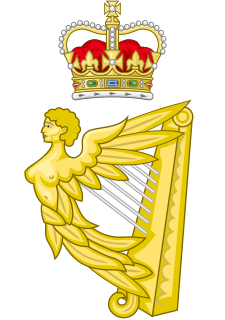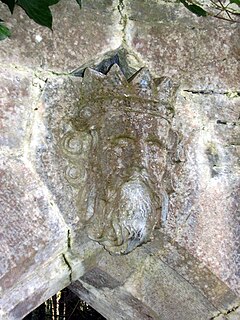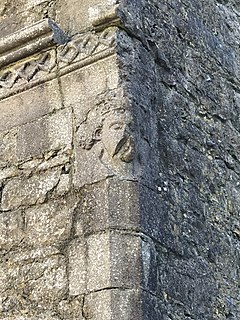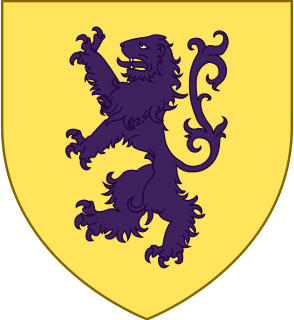| |||||
| Centuries: | |||||
|---|---|---|---|---|---|
| Decades: | |||||
| See also: | Other events of 1177 List of years in Ireland | ||||
Events from the year 1177 in Ireland.
| |||||
| Centuries: | |||||
|---|---|---|---|---|---|
| Decades: | |||||
| See also: | Other events of 1177 List of years in Ireland | ||||
Events from the year 1177 in Ireland.
| | This section is empty. You can help by adding to it. (February 2013) |

Monarchical systems of government have existed in Ireland from ancient times. In the south this continued until the early twentieth century, when it transitioned to the Republic of Ireland. Northern Ireland, as part of the United Kingdom, remains under a monarchical system of government.
Diarmait Mac Murchada, anglicised as Dermot MacMurrough, Dermod MacMurrough, or Dermot MacMorrogh, was a King of Leinster in Ireland. In 1167, he was deposed by the High King of Ireland, Ruaidrí Ua Conchobair. The grounds for the deposition were that Mac Murchada had, in 1152, abducted Derbforgaill, the wife of the king of Breifne, Tiernan O'Rourke. To recover his kingdom, Mac Murchada solicited help from King Henry II of England. His issue unresolved, he gained the military support of the Earl of Pembroke. At that time, Strongbow was in opposition to Henry II due to his support for Stephen, King of England against Henry's mother in the Anarchy. In exchange for his aid, Strongbow was promised in marriage to Mac Murchada's daughter Aoife with the right to succeed to the Kingship of Leinster. Henry II then mounted a larger second invasion in 1171 to ensure his control over Strongbow, resulting in the Norman Lordship of Ireland. Mac Murchada was later known as Diarmait na nGall. He was seen in Irish history as the king that invited the first-ever wave of English settlers, who were planted by the Norman conquest. The invasion had a great deal of impact on Irish Christianity, increasing the de facto ability of the Holy See to regulate Christianity in Ireland.

Ruaidrí mac Tairrdelbach Ua Conchobair was King of Connacht from 1156 to 1186, and High King of Ireland from 1166 to 1198. He was the last High King of Ireland before the Anglo-Normans invaded Ireland. Ruaidrí was the last native and Celtic King of Ireland.

Cathal Crobhdearg Ua Conchobair (1153–1224), was a king of Connacht. He was the youngest son of the High King of Ireland Tairrdelbach Ua Conchobair and brother to the last fully recognized High King Ruadri Ua Conchobair. His own sons Aedh Ua Conchobair and Feidhlimidh Ua Conchobair were kings of Connacht after him.
Toirdhealbhach Mór Ua Conchobhair anglicised Turlough Mór O'Conor, was King of Connacht (1106–1156) and High King of Ireland.
Felim McHugh O'Connor was king of Connacht in Ireland from January 1310 to 10 August 1316. The beginning of his kingship saw a revival in the ancient form of inauguration performed for the Kings of Connacht after a period of apparent lapse in the practice. His reign took place against the background of a Gaelic recovery following the Anglo-Norman invasion and the disputed High Kingship of Edwurd Bruce. He was the last King of Connacht to truly hold power over the entire province and his death halted the gains that had been made following the Anglo Norman invasion, by his kingdom. His foster father Maelruanid Mac Diarmata King of Magh Lurg would play an instrumental role in his reign.
Áed mac Felidlimid Ó Conchobair, known as Áed na nGall, was king of Connacht alongside his father Felim from 1258 reigning solely from 1265 until his own death in 1274. He is credited with turning the tide on Norman expansion into Connacht at the Battle of Áth an Chip. Aed took a different approach than his father to dealing with English crown authority in Ireland, placing his faith in alliances with the Gaelic speaking world and becoming the chief supporter of Brian Ua Neill's bid to revive the high kingship of Ireland. His byname na nGall comes from his marriage in 1259 to a daughter of Dubhghall mac Ruaidri King of the Hebrides which brought him 160 gallowglass commanded by Dubhghall's younger brother Ailéan as a dowry.
Toirdhealbhach Ua Briain, anglicised Turlough O'Brien, was King of Munster and effectively High King of Ireland. A grandson of Brian Bóruma, Toirdelbach was the son of Tadc mac Briain who was killed in 1023 by his half-brother Donnchad mac Briain.

The Anglo-Norman invasion of Ireland took place during the late 12th century, when Anglo-Normans gradually conquered and acquired large swathes of land from the Irish, which the kings of England then claimed sovereignty over, as sanctioned by the Papal bull Laudabiliter. At the time, Gaelic Ireland was made up of several kingdoms, with a High King claiming lordship over most of the other kings. The Norman invasion was a watershed in Ireland's history, marking the beginning of more than 800 years of direct English and, later, British involvement in Ireland.
Events from the year 1166 in Ireland.
Events from the year 1186 in Ireland.

Hugh de Lacy, 1st Earl of Ulster was an Anglo-Norman soldier and peer. He was a leading figure in the Norman invasion of Ireland in the 12th century, and was created Earl of Ulster in 1205 by King John of England.
Brian O'Neill, also known as Brian "of the battle of Down" O'Neill, was the High King of Ireland from 1258 to 1260.
Ruaidrí ua Canannáin was king of the Cenél Conaill, and according to some sources, High King of Ireland.

The Earldom of Ulster was an Anglo-Norman lordship in northern medieval Ireland, established by John de Courcy from the conquest of the province of Ulaid in eastern Ulster. It was the most important Anglo-Norman lordship in the north of Ireland. At its greatest extent it extended as far west as the Inishowen peninsula in modern-day County Donegal, which was at one time the power-base of the Northern Uí Néill.
Flaithbertach Ua Néill was king of Ailech, a kingdom of north-west Ireland. He abdicated in 1030 and undertook a pilgrimage to Rome, for which reason he was known as Flaithbertach an Trostáin. Following the death of his son Áed in 1033, Flaithbertach left his retirement and resumed the leadership of the Northern Uí Néill.
Ruaidrí Ua Conchobair, called Ruaidrí na Saide Buide was King of Connacht, perhaps twice.
Events from the 9th century in Ireland.
Donnchad Ua Cerbaill or Donnchadh Ó Cearbhaill, king of Airgíalla, fl. c. 1130–1168.
Áed in Macáem Tóinlesc or Aodh an Macaoimh Tóinleasg was a 12th-century ruler of Tulach Óc and Tír Eogain. He was the first of his family to play a significant role in the high politics of northern Ireland, following the death of the Muirchertach Mac Lochlainn king of Tír Eogain and high king of Ireland.